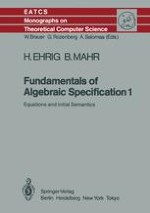The aim of this book is to present fundamentals of algebraic specifications with respect to the following three aspects: fundamentals in the sense of a carefully motivated introduction to algebraic specifications, which is easy to understand for computer scientists and mathematicians; fundamentals in the sense of mathematical theories which are the basis for precise definitions, constructions, results, and correctness proofs; and fundamentals in the sense of concepts, which are introduced on a conceptual level and formalized in mathematical terms. The book is equally suitableas a text book for graduate courses and as a reference for researchers and system developers.
